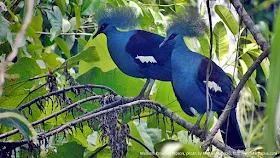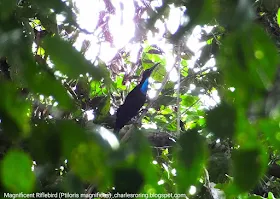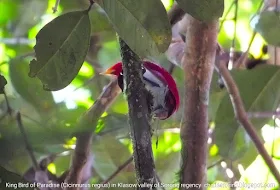As a matter of fact, the are other animals which tourists can see while walking in the jungle. Some of them include soa-soa lizards, wild pigs, snakes, frogs, birdwing butterflies, cuscus possum, tree kangaroo, and bandicoot. Insects have also been the focus of attention of some scientists who travel to Arfak mountains.
Trekking and Camping
The best way to explore the bio-diversity of the rainforest environment of Arfak range is by camping in the jungle and do the exploratory walks during the days and nights. The chance to see wild animals is higher if we stay in the jungle and explore deeper forest area. As a tourist guide, I have accompanied a lot of visitors on trekking and camping trips in the forest. They usually stay between 3 to 5 days.
Mabowi Forest of Arfak Mountains
I highly recommend Mawowi forest because it is still in pristine condition. Here, visitors can watch Lesser Birds of Paradise in the morning, explore trees, shrubs, lianas and mushrooms during the day and do night walk to find cuscus possum and Papuan frogmouth bird at night.
Itinerary
Here is a typical itinerary for visitors who want to go trekking and wildlife watching in Arfak mountains:
Day 1
Arrive in Manokwari
Getting Travel Permit (Surat Jalan) from local police station
Transfer to Arfak mountains
Overnight stay in the jungle tent
Day 2
Wake up early in the morning at around 4.30
Drink tea, or coffee. Leave the camp at approx. 05.00 for the display trees of Lesser Birds of Paradise (Paradisaea minor). Watch birds until 09.00.
Return to base camp. Have breakfast. Take a rest.
At 11.00, we can do the exploratory jungle walk to see tropical trees, bamboo, lianas, wild flower plants on the ground and orchids in high trees.
We can return to our camp again during the day or continue our trekking tour deeper and higher into the mountains.
Day 3
We can walk down the forest and continue exploring the forest in the lowland area of Arfak mountains.
We can built tents by a small river and do jungle walk during the day and at night.
Overnight stay in the jungle.
Day 4
We can dismantle our tents and walk back to the main road and return to Manokwari city by car.
 |
| Lake Anggi Gida |
The cost includes transportation between Manokwari city and the entrance point at the foot of Arfak mountains, food in the jungle, local guides.
The cost does not include airfare, travel insurance and hotel accommodation in Manokwari city. I can help you book a room in a hotel in this city.
How to go there?
- Fly from your country to Jakarta, the capital of Indonesia.
- Continue your trip to Manokwari city by a domestic airline such as Garuda, Sriwijaya, Express Air, Nam Air.
- I can meet you at the airport or at the hotel where you stay and arrange your trip to the mountains.
 |
| Traditional house of Sougb tribe in Arfak range |
I could organize a trip for you to Anggi lakes where you could see the villages that exist around the lakes, beautiful flowers, also meet and stay with the indigenous people in their traditional house.
Booking
Please, use the contact form in the top right side of this blog or send your email directly to my email: peace4wp@gmail.com






















